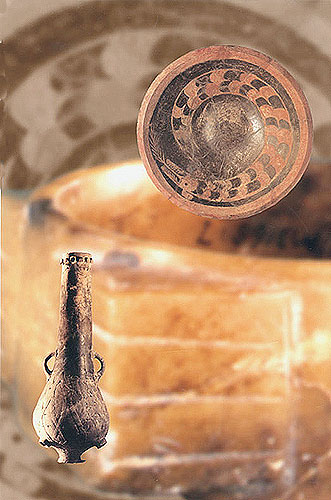Taosi site marks the origin of ‘central point’

This painted pottery tray with dragon design was excavated at the Taosi site. (File)
The forging of the Chinese civilization has been a process of integrating a variety of cultures, and so has the establishment of the Chinese nation been a process of development from states to kingdoms.
In the period of Longshan culture (3,000BC-2,000BC), the core of Chinese civilization ultimately took shape in the middle reaches of the Yellow River, and Taosi culture is representative of the states that served as a precursor to the Xia, Shang and Zhou dynasty-states in the central plain.
Taosi culture is named after the Taosi archeological site, which is located approximately 7 kilometers to the northeast of Xiangfen County, Linfen City of Shanxi province. It is seated on the gentle slope of a loess plateau at the intersection between the Taiyue Mountain range and Fenhe Valley. The Taosi site covers 3 square kilometers. From 1978 to 1985, archeological excavation confirmed that the Taosi culture appeared around 2,400 BC to 1,800 BC, and early royal graves showed signs of class antagonism.
The Taosi observatory excavated from the Taosi archeological site had the same function as England’s Royal Greenwich Observatory, marking the Taosi site as the center of the realm. Authorities living inside these states were regarded as being at the center of power, and they were the sole representative of heaven on earth. Represented by Taosi culture, these states became the center of the land that would one day become China.
Because the Taosi states lacked sophistication in terms of political ideas and ruling methods, such as literary virtue and systems of succession, the culture ultimately fell into ruin. In the late period, outside invaders conquered the state. Although many fleeting attempts were made to restore rule, the state power of Taosi with its culture was thoroughly destroyed before it had the chance to successfully establish a dynasty in the central plain.
This historical opportunity has ultimately seized by Henan Longshan Culture (2,600BC-2,000BC), which is the Third Stage of Wangwan Culture. It wasn’t until the period of Erlitou Culture (1,900BC-1,500BC) that the earliest dynasty-state, known as the Xia, was born in the Yiluo Plain, launching a new era of the Xia, Shang and Zhou dynasties. And the traditional “center” of China shifted from the south of modern-day Shanxi province to the Yiluo Plain, represented by Luoyang City.
He Nu is from the Institute of Archaeology at the Chinese Academy of Social Sciences.
The Chinese version appeared in Chinese Social Sciences Today, No. 665, Nov. 5, 2014
The Chinese link: http://sscp.cssn.cn/xkpd/bowu/201411/t20141105_1390328.html
Translated by Zhang Mengying
Revised by Justin Ward

 PRINT
PRINT CLOSE
CLOSE